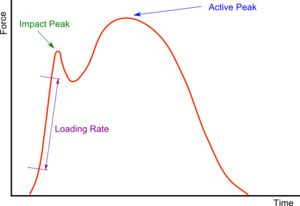Impact Forces in Running
A common concern for runners is the impact that occurs and of the possibility of related injuries. While the relationship between impact and injury is less clear than one might suppose, this article focuses on how impact is measured and how variations on measurement approach might be important.
1 Ground Reaction Forces
The traditional way of measuring the impact of running is to look at the Ground Reaction Forces. This involves having the runner land on a special plate that will detect the forces, which limits its usefulness in every day training. In fact, it's even a little limited in the laboratory as it's not practical to get data from many footsteps. The data gathered is based on how the foot (or more normally the shoe) pushes on the ground. Typically, these forces are normalized to the body weight of the runner, and values are often seen of between 1.5x and 3x the runners body weight. Studies looking at the impact of running using Ground Reaction Forces can choose different parts of the impact curve as their metric. The diagram below shows a typical Ground Reaction Forces curve of force against time for a single footfall.
- Peak Impact is the greatest force seen during the initial landing. This small peak before the main landing is often only seen on Rear Foot Strike landing.
- Active Peak is the greatest force detected during foot strike.
- Loading Rate is how rapidly the forces build up and can either be averaged over parts of this section of the graph or an instantaneous peak can be used. This is a measure of how steep the curve is during this initial landing.
2 Acceleration
While Ground Reaction Forces are the traditional way of evaluating a runner's impact in a laboratory, the availability of small and relatively cheap accelerometers has opened up new possibilities for measuring impact. There are a number of variables to consider when looking at a Running Sensor to evaluate impact.
- Axis. Accelerometers can be either a 3-axis or 9-axis sensor. A 3-axis sensor simply measures acceleration in each of the three directions, which is sufficient for simple impact evaluation. A 9-axis sensor adds the ability to measure rotational movement in the three axis. (A 9-axis sensor also include a 3 axis compass.) This ability to measure rotation can be useful for understanding things like Foot Strike. For instance, if the foot rotates so the toes continue to descend after the initial impact then you know that the runner landed on the heel.
- Jerk. Just like Ground Reaction Forces, the impact can be evaluated as the peak acceleration or it can be based on how quickly the acceleration builds up. This rate of change of acceleration is called Jerk in physics. (It's also called the third derivative of position, but "Jerk" is more entertaining and more intuitive.) There is some evidence that Jerk may be more relevant to injury rates than acceleration on its own. However, I don't think the evidence is compelling enough to form any definite conclusion. That said, it's important to know if your sensor is showing you impact has acceleration or Jerk. I suspect that Jerk could be a little misleading, as relatively low acceleration that builds up very quickly would be considered a higher impact than relatively high acceleration the builds up more gradually. It seems to me to be possible that the 2 values might be combined in some way, but I've not seen that approach used. Sensors that use Jerk include the Wahoo TICKR Run ("Smoothness") and MilestonePod ("Rate Of Impact (ROI)").
- Location. Where the impact is measured is important. Acceleration is only part of the physics of the forces involved in running impact, so you have to consider the mass that is undergoing the acceleration. For instance, if you hit a ping pong ball, there is huge acceleration, but because the ball is so light there's very little force generated. For runners, putting the sensor on the foot tends to give quite high acceleration values. This might be quite important if you're worried about stress fractures of the bones in the foot, especially the metatarsals. However, your foot only makes about 1-2% of your body weight so the forces involved in your foot landing might be a little misleading. After your foot is made contact, the movement of your ankle can significantly reduce the acceleration that your lower leg (tibia) undergoes. A similar process of absorbing the acceleration can occur at the knee and hip. Measuring the acceleration of your torso might give the best estimation of the forces of impact as that would represent the bulk of your body's mass. Measuring the acceleration of the lower or upper leg may give a much better indication of stresses on the knee, though more research is warranted.
